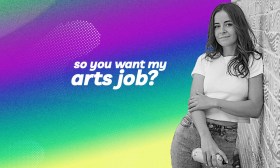When I was instructed on where to buy my boss’s lunch according to whether his hangover was from alcohol or cocaine I realised that the coveted “internship at a cutting edge contemporary gallery” was perhaps not all it was cracked up to be. I had just left university and, like all twenty-somethings who do not go straight into the City, I was trying to look qualified. Looking qualified meant working for free in as many places as would have me.
For the next couple of years I interspersed my post-graduate education with as many jobs/internships I could get. My original interest in museums and heritage shifted to commercial and modern work. Despite fantastic experiences at the Metropolitan Museum in New York and The National Gallery in London, I came to realise that I enjoyed the business and buzz of being in a commercial environment and working with a living market.
The art world can, at times, feel impenetrable. Degrees and theses will get you so far but nepotism and connections will get you further. You could cry at how many times you hear the phrases “My father knows someone…” or “Oh he was just someone I sailed with and it turned out they needed someone…”. A combination of hard graft and calling in favours from anyone I knew who vaguely liked paintings eventually made my CV look acceptable.
The notion of the “internship” seemed completely alien to my parents: “you mean you’ll just work for free?” and “why don’t they just give you a job?” were common questions.
To be honest, the notion of an internship is also completely alien to many institutions that offer them with galleries enjoying slave labour and offering very little in terms of real experience.
The Americans do it properly: at the Met I was inducted and introduced to the company. My boss was a dream, a master of her subject and a voracious wit. Within a couple of weeks, I was writing exhibition text, giving tours and looking after visiting dignitaries. The responsibility terrified me but I have never learned so much so quickly.
Experiences in British institutions varied wildly, some people just did not know what to do with me and offered me three hour lunch breaks because they could not think of anything for me to do. Some relished the prospect of someone gullible enough to work for so little and expected me to waitress for free at parties held by speed dating services that had just happened to hire the space. A few actually gave me work to do.
Aside from aiding hangover cures I did everything: I photocopied entire exhibition catalogues seven times; I picked up visiting Egyptian curators who spoke very little English from the airport at midnight; I tested the contents of hotel rooms that dignitaries would be staying in to make sure that the pay-per-view was easy to work; I spent half an hour becoming a specialist on Scandinavian modernist painting in order to give a lunch time talk in place of someone that was off sick and I hung over one hundred drawings by Frank Auerbach in two days.
It is difficult not sound ungrateful and avoid comparisons with The Devil Wears Prada syndrome where educated university graduates expect a glamorous career to be handed to them because they wrote for the student newspaper or curated their final year art show. But it is still hard not to wonder how larger institutions get away with making unpaid or under minimum wage positions so competitive and offering very little in return.
The truth is that regardless of what you are asked to do or how patronised you feel it is the only way to gain experience and figure out what you want to do. The art world is extremely competitive and if you want a good job in an important city the internship is the way forward.
The point is that all internships are in some sense exploitative but now we’re all expected to do them and it is what you gather from the experience that counts.
The humiliation and embarrassment of being called “just an intern” or being told “of course I don’t expect you to know” when you have two post-graduate degrees can make working for Anna Wintour look very appealing. But it’s just what we do now.
The process of applying for them alone is a lesson in tailoring your writing, tone and interview technique. Plus you get few funny stories about clients buying enormous amounts of pornography on pay-per-view and trying to bill it to the museum or gallery or looking at a picture upside down for a good fifteen minutes before a clued up technician politely suggests you turn it around 180 degrees.
And, if you are early for work, you can often be the only person in a room full of the most exciting, expensive and gorgeous art in the world. Your more sensible friends in the City cannot claim to have done anything half as fun with their day.



